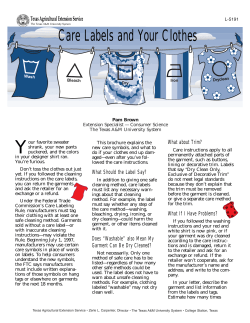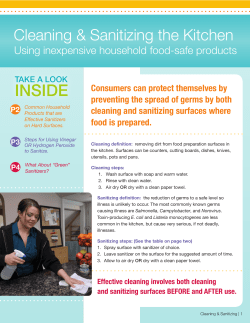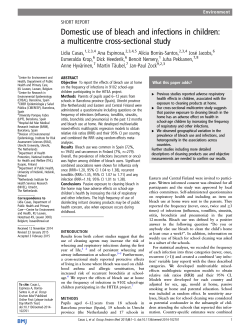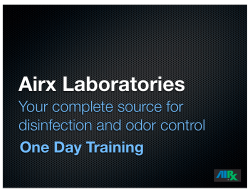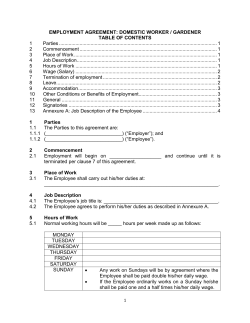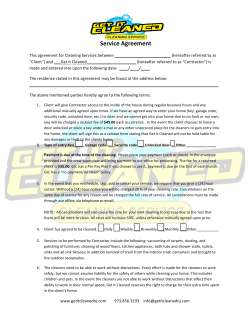
Sanitize Safely and Effectively: Bleach and Alternatives in Child Care Programs
Health & Safety Notes Sanitize Safely and Effectively: Bleach and Alternatives in Child Care Programs Proper cleaning and sanitation are important to keep child care centers healthy. Young children sneeze, cough, drool, use diapers and are just learning to use the toilet. They hug, kiss, touch everything, put things in their mouths and readily spread germs. In addition, infants, toddlers and preschoolers have immature immune systems and experience more illnesses than older children or adults, especially when they spend time in child care settings. Sanitizing reduces the risk of illness by decreasing bacteria, viruses, fungi, and mold. Community Care Licensing regulations require that child care personnel are trained in housekeeping and sanitation principles and that facilities are kept clean and sanitary. What is the difference between cleaning, sanitizing and disinfecting? Sometimes these terms are used interchangeably, but they are not the same. They have different outcomes and are legal terms defined by the Environmental Protection Agency (EPA). EPA Standard Definitions Clean The process that physically removes debris from the surface or area by scrubbing, washing and rinsing. It may be accomplished with soap or detergent and water. Sanitize Product that kills 99.9% germs identified on its label. DisinfectProduct that kills nearly 100% of germs identified on its label. The EPA, a US government agency, tests if a product kills germs and checks if it poses unreasonable health hazards. Only products with EPA registration numbers on the label can make public health claims. If a product is not registered as a sanitizer or disinfectant with the EPA, it can only be relied on for cleaning and not for killing germs. Proper cleaning (washing and rinsing with a soap or detergent) must be done before sanitizing. This step is needed since soil can prevent disinfectants from working. In child care settings, sanitizing will kill enough germs to reduce the risk of becoming ill from contact with the surface. Disinfecting (the higher level of germ killing) is recommended for blood spills to decrease the risk of spreading bloodborne illnesses such as HIV and Hepatitis B. Why do so many child care programs use bleach? Bleach is widely used to sanitize and most often recommended for child care programs. If used correctly, bleach reliably sanitizes and disinfects non-porous surfaces of common and harmful bacteria and viruses. It has a short killing time and it does not need to be rinsed since it breaks down quickly into harmless components. A low concentration is required for sanitizing and disinfecting and it is very inexpensive. Currently, there is no substitute for bleach that is as economical and effective. What are the problems with using bleach? Bleach is a chemical irritant. It can irritate the lungs and mucous membranes. In its concentrated form, it can damage skin, eyes and clothing. For staff who mix bleach solutions, contact with full strength bleach can be harmful. Caution must be taken when mixing bleach. Some recent research has linked the fumes of cleaners, sanitizers, disinfectants and other chemical irritants with asthma. All disinfectants and sanitizers, by design, are potentially toxic. Young children are more vulnerable to toxins. They breathe more per pound than adults and are growing and developing at a rapid rate. They also have more hand to mouth activity. Although proper use of bleach has not been proven to be harmful to children in child care settings, parents, teachers and researchers are questioning all possible toxins, including bleach. Are there alternatives to bleach? As long as a product is registered with the EPA as a sanitizer or disinfectant (check the product label) and is used according to the directions on the label, it can be used in child care settings. Alternatives to bleach that are registered with the EPA are generally grouped as: quaternary ammonium compounds (“quats”), iodine based sanitizers, acid anionic sanitizers (peracetic acid), and hydrogen peroxide sanitizers. Sanitizers and disinfectants other than bleach have benefits as well as limitations. For example, when using “quats” a longer contact time is required and the product needs to be rinsed off if it is used on a surface that may be mouthed by children. As with bleach, proper cleaning of equipment and surfaces with soap or detergents before applying the sanitizer may be required. What about “green cleaning”? While there is much interest in the child care community about environmentally friendly products, “green cleaning” should not mean accepting a lower standard for sanitation. Cleaning performed before sanitizing or for surfaces that don’t require the extra step of sanitizing can be done with eco-friendly products. HEPA filter vacuum cleaners and microfiber cloths and mops are also effective non-toxic tools for removing dirt and soil. Green Seal and other environmental rating groups certify cleaners that are environmentally preferable. Environmental rating groups do not rate if a product is effective at killing germs. Only the EPA registers sanitizers and disinfectants. Do environmentally friendly products such as baking soda, vinegar, or borax sanitize? While these products can be used to physically remove dirt and debris (clean) by scouring and wiping surfaces, they do not kill germs well enough to be used to sanitize in child care. So, although they may be good, low cost choices for cleaning, the extra step of sanitizing is still needed for many surfaces in child care. Are there any natural disinfectants? A botanical disinfectant called Benefect is an EPA registered disinfectant. As an EPA registered disinfectant, it can be used to sanitize in child care when used according to label. It does not need to be diluted or rinsed. It is much more expensive than bleach, and has a ten minute contact time. What about hydrogen peroxide sanitizers? Products with hydrogen peroxide as the active ingredient are being used by some child care programs as alternatives to bleach. Hydrogen peroxide breaks down to water and oxygen and does not leave harmful residues. Peroxide sanitizers offer an alternative to more toxic cleaners, because they do not introduce irritating fumes into the air. Always check the product label for EPA registration and follow the directions for sanitizing. By Bobbie Rose, R.N. Research help from Suzi Caflin, Intern, Alameda County Child Care Planning Council. Resources and References EPA, www.epa.gov/oppad001/ad_info.htm Caring for Our Children: National Health and Safety Performance Standards, 2002 Sensible Life Products www.sensiblelifeproducts.com California Community Care Licensing Regulations www.dss.cahwnet.gov/ord/PG587.htm Recommendations for Cleaning, Sanitizing and Disinfecting www.ucsfchildcarehealth.org/pdfs/healthandsafety/ recommenEN_adr.pdf 10/08 California Childcare Health Program • 1950 Addison Street, Suite 107 • Berkeley, CA 94704-1182 510–204-0930 • Fax 510–204-0931 • Healthline 1-800-333-3212 • www.ucsfchildcarehealth.org Telephone What is safe and effective use of bleach? EPA Standard Definitions Clean he process that physically removes debris from the surface or area by scrubbing, washing T and rinsing. It may be accomplished with soap or detergent and water. Sanitize Product that kills 99.9% germs identified on its label Disinfect Product that kills nearly 100% of germs identified on its label. When used appropriately, much of the risk of harm from bleach can be reduced. Follow these steps when preparing and using bleach to sanitize: To safely prepare bleach dilutions: To safely use bleach solutions: •Dilute bleach with cool water and do not use more than the recommended amount of bleach. •Apply the bleach dilution after cleaning the surface with soap or detergent and rinsing with water. •Make a fresh bleach dilution daily; label the bottle with contents and the date mixed. •Wear gloves and eye protection when diluting bleach. •Use a funnel. •Add bleach to the water rather than water to bleach to reduce fumes. •Make sure the room is well ventilated. •Never mix or store ammonia with bleach or products that contain bleach. •Allow for a two-minute contact time or air dry. •Sanitize with bleach when children are not present. •Ventilate the room and allow the surfaces to completely dry before allowing children back into the area. •Store all chemicals in a secure area, out of reach of children and in a way that they will not tip and spill. Recommended Bleach Dilutions For food contact surface sanitizing (refrigerators, freezers, plastic cutting boards, stainless cutlery, dishes, glassware, countertops, pots and pans, stainless utensils, toys that have been mouthed, high chair trays) 1 Tablespoon of bleach to a gallon of water. For nonporous surface sanitizing and disinfecting 1/4 cup of bleach to one gallon of water or 1 tablespoon per quart. Let stand for 2 minutes or air dry. Let stand for 2 minutes or air dry. 10/08 California Childcare Health Program • 1950 Addison Street, Suite 107 • Berkeley, CA 94704-1182 510–204-0930 • Fax 510–204-0931 • Healthline 1-800-333-3212 • www.ucsfchildcarehealth.org Telephone
© Copyright 2025



